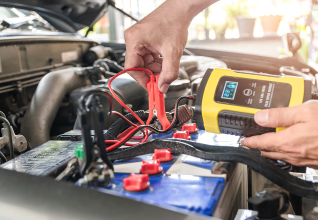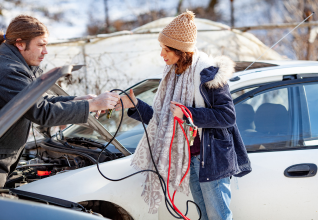Imagine you are ready to leave, but your car won’t start. The offender? an empty battery. Do not worry; this thorough guide will teach you how to safely and effectively charge a car battery. We’ll look at various strategies, instruments, and safety measures to assist you in swiftly getting back on the road. So fasten your seatbelt, and let’s begin!
How to Charge a Car Battery: The Basics
Choose the Right Charger

Selecting the appropriate charger for your car battery is crucial before getting into the details. Several types of chargers are available on the market, including trickle, smart, and jump starters. Select a charger that is appropriate for the type of battery you are using.
Safety First
Charging a car battery can be hazardous if not done correctly. Always wear gloves and goggles to protect yourself from acid spills or sparks.
Preparing for the Charge
Make sure your vehicle is off and properly ventilated before you begin. Look for rust or dirt on your battery terminals, and clean them if necessary.
Step-by-Step Guide: How to Charge a Car Battery
Step 1: Connect the Charger
First, connect the charger’s positive (+) clamp to the battery’s positive terminal, followed by the negative (-) clamp to the negative terminal. Make sure the connections are secure.
Step 2: Set the Charger
Choose the appropriate settings for your battery type, size, and desired charging speed. Most chargers have an automatic mode, a safe bet for most situations.
Step 3: Power Up the Charger
Plug in the charger and switch it on. Keep an eye on the charging progress and ensure everything runs smoothly.
Step 4: Disconnect and Test
Once the charger indicates the battery is fully charged, disconnect the charger and test your car. If it starts without any issues, you’re good to go!
Alternative Methods: Charging Your Car Battery on the Go
Jump-starting Your Car Battery
Make sure your vehicle is off and ventilated before you begin. Look for rust or dirt on your battery terminals, and clean them if necessary. You can use another vehicle to jump-start your car’s battery in an emergency. Jumper wires should be connected between the two batteries. Start the running vehicle first, and then try to start the dead vehicle.
Solar Chargers
Drivers concerned about the environment might choose solar chargers that use the sun’s energy to recharge vehicle batteries. Although usually slower, these chargers make excellent backups.
Safety Tips: Charging Your Car Battery with Confidence
Don’t Overcharge
Overcharging can damage your battery, so follow the manufacturer’s charging times and voltage guidelines.
Ventilation is Key
Charging a car battery can produce hydrogen gas, which is highly flammable. Charge your battery in a well-ventilated area to avoid any dangerous gas build-up.
Keep an Eye on the Temperature
Batteries can get hot while charging. Monitor the temperature and stop charging if the battery becomes too hot to touch.
Keep Children and Pets Away
Charging a car battery can be hazardous, so ensure that children and pets are kept safe.
Troubleshooting: Common Issues and How to Fix Them
Charger Not Working
Check the connections, power source, and settings if your charger isn’t working. If the issue persists, investing in a new charger might be time.
Car Still Won’t Start
If your car doesn’t start after charging, you may have a more severe problem, such as a faulty alternator or starter motor. If you need further assistance, contact your mechanic.
FAQs
How long does it take to charge a car battery?
The time it takes to charge a car battery depends on the charger’s output and the battery’s capacity. It can range from a few hours to over a day.
Can I charge a car battery while it’s still connected to the car?
Yes, you can charge your car battery while connected to your car. However, be sure to follow the necessary safety precautions and guidelines.
How do I know when my car battery is fully charged?
An indicator displaying when the battery has been fully discharged is included in many chargers. The battery’s voltage, which is expected to be between 12.6V and 12.9V for full-charge batteries, can also be measured using a multimeter.
Can I overcharge my car battery?
Yes, overcharging can damage the battery. Follow the manufacturer’s guidelines for charging time and voltage to prevent overcharging.


